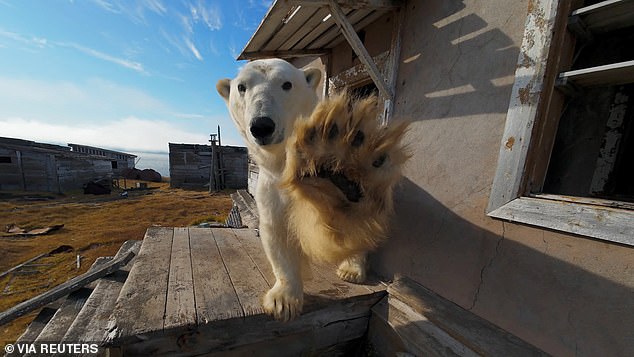A group of polar bears have taken over an arctic Russian island and now live among its abandoned buildings.
Dozens of bears roam freely on Kolyuchin Island, in Russia‘s Chukchi Sea, hopping between windowless buildings and making themselves at home.
The 11km island off Russia’s far eastern coast has no human population and was once used as a Soviet weather station.
But the Kolyuchin station was abandoned following the collapse of the Soviet Union in the early 1990s.
New drone footage, captured by photographer Vadim Makhorov, show the large bears inside empty homes, resting on porches and looking out of windows.
Around 20 bears are running around the island he said, adding there is a nearby bed of walruses.
Birds eye photographs show deserted buildings scattered across the island, with bits of debris dispersed.

Dozens of polar bears roam freely on the abandoned Russian arctic Kolyuchin Island

A group of polar bears have taken over the island and now live among its abandoned buildings

The animals hop between windowless buildings and are pictured making themselves at home

A group of up to 20 bears lives undisturbed on Kolyuchin Island, in Russia’s Chukchi Sea
Others show the bears relaxing, yawning, lying on stairs and sitting on the floor.
Some peer through windows while others are seen exploring the island’s terrain.
‘Bears are no strangers to the feeling of comfort and coziness,’ he wrote in a social media post. ‘They perceive homes as shelter.’
In another post, he wrote: ‘Polar bears like to occupy at home. This happens not only in Kolyuchin. Any polar base with its door open is at risk of getting new furry inhabitants.
‘For example, at the ZFI in Pacific Bay, where the very first Soviet polar station is preserved, there are also many such houses.
‘And before you feel calm on the base, you need to walk and look at every house, make some noise so that the bears move away from people.
‘Polar bears also try to break into residential polar bases. To prevent this from happening, polarists put bars with spikes on the windows, put ‘bear slippers’ – boards with nails in front of the door.
‘Bears certainly don’t step on nails or get traumatized. They see them and just don’t climb the door.’

The 11km island off Russia’s far eastern coast has no human population and was once used as a Soviet weather station

New drone footage show the large bears inside homes, resting on porches and looking out of windows

Around 20 bears are thought to be running around the island, photographer Vadim Makhorov said

Some bears peer through windows while others are seen exploring the island’s terrain

One polar bear can be seen poking its face towards the drone

The houses, which have been taken over by the bears, were abandoned when the Soviet Union fell

While some were pictured exploring the islands, others were spotted taking shelter in the empty houses

Bears are no strangers to the feeling of comfort and coziness,’ he wrote in a social media post. ‘They perceive homes as shelter,’ photographer Vadim Makhorov said

Photographs show the bears relaxing, yawning, lying on stairs, sitting on the floor and exploring the environment

The bears roam around the island which has deserted buildings and bits of debris scattered across

‘Polar bears like to occupy at home. This happens not only in Kolyuchin. Any polar base with its door open is at risk of getting new furry inhabitants,’ Makhorov said
The polar bears on Kolyuchin Island are not the first to take over an arctic weather station.
Scientists were forced to drive away dozens that besieged a station in Troynoy island, in the Kara Sea north of Siberia in 2016.
Five scientists based at the station were encircled by 10 adult bears and some cubs.
Two resident dogs were killed by the bears, while one female bear spent the night beneath its windows.
A nearby ship reached the island and supplied the scientists with dogs and flares to scare them off.
Before the ship arrived, scientists were advised to ‘use extreme caution’ and to remain inside the station.
This article was originally published by a www.dailymail.co.uk . Read the Original article here. .

